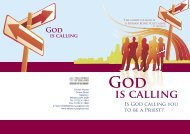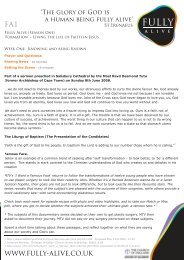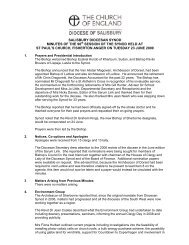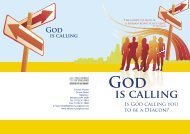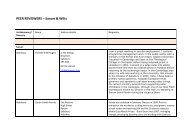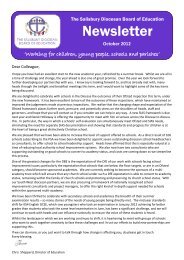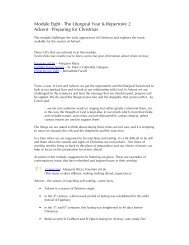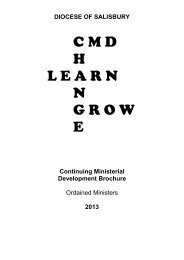Life after Death
Life after Death
Life after Death
- No tags were found...
You also want an ePaper? Increase the reach of your titles
YUMPU automatically turns print PDFs into web optimized ePapers that Google loves.
APPENDIX UExemplar Unit of Work: <strong>Life</strong> <strong>after</strong> deathThis unit of work contributes towards the principal aim of RE in Wiltshire:to engage pupils in enquiry into key questions arising from a study of religion and belief, so as topromote their personal and spiritual development.Step 1:The themeStep 2: KeyquestionStep 3:LearningoutcomesandassessmentThe journey of life and death: why some occasions are sacred to believers, and whatpeople think about life <strong>after</strong> death;Ensure that you have considered any pupils who have experienced a difficult ortraumatic family event, or have experienced loss within their family. As well as thepreparation letter, contact particular families and seek their advice if in any doubt.Why do some people believe in life <strong>after</strong> death and what difference does it make?This unit is designed as an enquiry based unit which may be taught over a series ofweeks or in a shorter, more concentrated period such as during an RE week. It isimpossible to write a pure child led enquiry this way and so the unit assumes somequestions your pupils might choose to investigate and suggests ways to investigatethem. What you do in this unit will depend on the questions generated by the childrenin your class.Examples of questions that children might come up with are in red, the adultpresentation of that question to the whole class then appears in black.Where does this fit into our Key Stage planning?It may fit in with a broader study around Easter or with work around life cycles inScience. This work is most suited to children aged 9-11.We are focusing on what happens when we die, so have selected the followinglearning outcomes:i. identify some mysterious and puzzling questions that religions help some peopleto find answers to;ii. ask questions and suggest answers to the question ‘what happens when we die’in the context of religious and non religious beliefs;iii. explain why a believer may wish to mark the end of life with a particular religiousceremony;iv. explain how different beliefs about what happens when we die may cause peopleto live their life in different ways;v. express their own beliefs about life <strong>after</strong> death reflecting on ideas from at leasttwo religions they have studied.These learning outcomes are turned into levelled “I can...” statements in the teachingand learning activities below.Level 2Identify a Christian belief about life and deathIdentify a belief from a religion other than Christianity about what happens when we dieSuggest three questions about life and death that are interesting and hard to answerLevel 3Describe the difference between a description of my physical appearance anddescribing what makes me the person I am?Describe the Hindu belief in reincarnationDescribe the beliefs about judgement held by ChristiansMake a link between a reading that might be used at a funeral and a Christian beliefabout life <strong>after</strong> deathWiltshire Agreed Syllabus for Religious Education 2011 – Appendix U Page 1 of 14
APPENDIX UKey question: Why do some people believe in life <strong>after</strong> death and what difference does it make?LearningoutcomesTeachingshouldenablepupils to...i. identifysomemysteriousandpuzzlingquestionsthatreligionshelp somepeople tofindanswers to;Teaching and LearningTeachers can select from the following and adapt as appropriate, making sure that thelearning outcomes are met and that pupils’ learning needs are addressed.This material need not be taught as a whole unit but can be linked to work in othersubject areas.Ask Questions: Set up an enquiryAsk the pupils to cast their mind back to when they were younger and asked all sorts ofquestions that are difficult to answer e.g. Where does the sea end? Can they remember somethey used to ask? Explain that these questions are answerable but sometimes theexplanations are very complicatedTalk to the pupils about life‟s big questions or „Ultimate Questions‟. You may want to thinkabout questions such as „Is there a God?‟ or „How did the world come to be?‟ Use thisdiscussion to introduce the unit question, „Why do some people believe in life <strong>after</strong> deathand what difference does it make?’Sharing a story to generate questionsRead a story such as „Heaven‟ by Nicholas Allan. Use this as a stimulus to generate thekind of questions and answers that can surround death and dying.Draw on the board a stick person with a speech bubble containing a question markcoming out of their mouth. Share with the children that the person is sad because theirdog has died. Ask the children to write any questions that this person might have aboutdeath.Collect the pupils questions. Analyse the questions and group the questionsAs a class identify a few key questions that you want to find some answers to in the unit.Remind them that there may be lots of different answers. Express why the questions havebeen chosen.Ask the pupils to share any answers they might have to the questions chosen.Give pupils space and time to reflect and respond to the question, sharing personalstories, experiences, fears and questions.Levelled pupiloutcomes:so that pupilscan say “Ican...” to one ormore of thestatementsbelow.L2Suggest threequestions aboutlife and deaththat areinteresting andhard to answerL3Ask somequestions of myown about life<strong>after</strong> death andsuggest twodifferent answersto the questionsNotesBefore startingstudy in this unit aletter informingparents of the topicshould be senthome.As this is anenquiry based unitpupils will createtheir ownquestions,adapting the keyquestion so theycan enquire whatmost interests andchallenges them.Ultimate questionsIs there a God?If there is how canwe communicatewith God?How did the worldbegin?How should we liveWiltshire Agreed Syllabus for Religious Education 2011 – Appendix U Page 3 of 14
APPENDIX UExplain to the pupils that they have received a letter from the character in the book, Lil, askingwhat will happen when she dies? The learning that they do and their own questions that theyanswer will enable them to write a class response to her question at the end of the unit ofwork.The questions that follow are sample questions that children may develop. Use thequestions and material appropriate to your children. You do not need to use all of thismaterial.our lives?What happenswhen die?Heaven - NicholasAllanRed Fox books978-0099488149Wiltshire Agreed Syllabus for Religious Education 2011 – Appendix U Page 4 of 14
APPENDIX UKey question: Why do some people believe in life <strong>after</strong> death and what difference does it make?LearningoutcomesTeaching shouldenable pupils to...ii. ask questionsand suggestanswers to thequestion ‘whathappens when wedie’ in the contextof religious and nonreligious beliefs;iv. explain howdifferent beliefsabout whathappens when wedie may causepeople to live theirlife in differentways;Teaching and LearningTeachers can select from the following and adapt as appropriate, making sure that thelearning outcomes are met and that pupils’ learning needs are addressed.This material need not be taught as a whole unit but can be linked to work in othersubject areas.InvestigateSelect from and use a variety of skills to work with relevant material, to address theenquiry questionThe following activities will be selected from depending on the questions the class havechosen to investigate?What do some people think carries on <strong>after</strong> we have died? What is our soul?Exploring beliefs about the soulAsk pupils to fold a piece of A4 paper in half, landscape. Ask them to then draw aportrait of themselves on one side and write their characteristics and personality traitsdown the other side. Ensure that pupils suggest characteristics and not physicaldescriptions.Give pupils the opportunity to represent visually the soul or spirit. Use your own portraitand description to illustrate the concept of spirit or soul by showing that at the point ofdeath, everyone believes the body is finished with. Show this by tearing down themiddle and throwing it away. Retain the characteristics/personality and explain that thisrepresents what is known by many people as a person‟s spirit or soul. Religions try toanswer the question what happens to the soul or spirit when we dieReflecting and respondingAllow pupils time to discuss this idea of the soul. What do they think it looks like? Whathappens to it when we die? Where does it come from? Do animals have souls? Doesthe spirit or soul have anything to do with God?Give pupils space, time and resources to capture their ideas about the spirit or soul in words,pictures or other appropriate form.If part of a person lives on does that affect how you live your life now?Levelled pupiloutcomes:so that pupilscan say “Ican...” to oneor more of thestatementsbelow.L3Describe thedifferencebetween adescription ofmy physicalappearanceand describingwhat makes methe person Iam?L4Describe theimpact that thebelief that wehave a soulmight have onthe waysomeone mightlive their lifeNotesAll theanswers tothis questiondepend on anunderstandingof the spirit orsoul. It canbe quite adramaticmoment whenthe ‘body’side isseparatedfrom the‘spirit’. Onlyuse yourportrait, neverone of thepupils’.Wiltshire Agreed Syllabus for Religious Education 2011 – Appendix U Page 5 of 14
APPENDIX UKey question: Why do some people believe in life <strong>after</strong> death and what difference does it make?Learning outcomesTeaching should enablepupils to...ii. ask questions andsuggest answers to thequestion ‘what happenswhen we die’ in thecontext of religious andnon religious beliefs;iv. explain how differentbeliefs about whathappens when we diemay cause people to livetheir life in different ways;Teaching and LearningTeachers can select from the following and adapt asappropriate, making sure that the learning outcomes are metand that pupils’ learning needs are addressed.This material need not be taught as a whole unit but can belinked to work in other subject areas.InvestigateDo some people believe that you come back to life as adifferent thing? What is reincarnation?Sharing ideas of reincarnation and karmaUse the image of a ladder. Ask pupils to imagine this ladderrepresents life, with the best people at the top and the lowestanimals at the bottom. Ask pupils to discuss this and thendraw their own. Who might be at the top and who at thebottom? Where would they place themselves? Use thisimage to introduce and explain the belief of reincarnation.Ensure pupils understand the purpose for believers is to get tothe top of, then off, the ladder completely, to become one withGod.Move on to use the image to introduce and explain theconcept of „Karma‟. Once understood, challenge the pupils toconsider what qualities can be found in humans at differentpoints of the ladder. What qualities and habits would movepeople up and down? Ask them to annotate their ladder withthese.Sharing their ideasPupils can then respond through writing/drawing. Who, wouldbelievers say, decides who is at the top/bottom and which habit orbehaviour is important? Will people behave differently in life if theybelieve in reincarnation? Why?Levelled pupiloutcomes:so that pupils cansay “I can...” to oneor more of thestatements below.L3Describe the Hindubelief in reincarnationL4Show understanding ofthe Hindu belief inReincarnation and howbeing reincarnated canbe seen as curserather than a blessing.L5Explain the impact fora Hindu, of a belief inreincarnation, in aseries of areas of theirlife.NotesMore detail on this lessoncan be found in Exploringthe journey of life and<strong>Death</strong> Ed. Joyce MackleyRE Today servicesIt is easy for pupils tobecome attracted to theidea of reincarnationwithout understanding thebelief that the cycle of lifeis there to be broken byliving a good life and one’ssoul going to Heaven.Ensure pupils make a linkbetween a belief inreincarnation and living alife of good ‘Karma.’The Hindu philosophysays that the body is justthe outer garment of theindividual. The real selfdoes not die but goes onand assumes anotherbody. <strong>Death</strong> is when thesoul leaves the body.Wiltshire Agreed Syllabus for Religious Education 2011 – Appendix U Page 6 of 14
APPENDIX UKey question: Why do some people believe in life <strong>after</strong> death and what difference does it make?LearningoutcomesTeaching shouldenable pupils to...ii. ask questionsand suggestanswers to thequestion ‘whathappens when wedie’ in the context ofreligious and nonreligious beliefs;iv. explain howdifferent beliefsabout whathappens when wedie may causepeople to live theirlife in differentways;Teaching and LearningTeachers can select from the following and adapt as appropriate, making sure thatthe learning outcomes are met and that pupils’ learning needs are addressed.This material need not be taught as a whole unit but can be linked to work in othersubject areas.InvestigateDo you get to heaven if you do things wrong?JudgementUse the image of a set of weighing scales to introduce and explain the concept of„judgement‟, with good deeds weighed on one side and „bad‟ deeds on the other.Discuss with pupils what the word „judgement‟ means.Scoring your lifeOnce understood, challenge pupils to consider what „pass mark‟ they would set forentry into a happy <strong>after</strong>life. What qualities and habits would be found in people who„passed‟? Ask pupils to imagine that they are in charge for the day of who gets intoHeaven. Pupils need to be able justify why they have set the pass mark where theyhave. They can then complete the sentence „If the roof fell in now, I would score _out of ten‟. Ask pupils to discuss who or what type of people they think score highlyand who would receive a low score. What do you think your score is now and whatdo you do to increase or decrease your score? After this discussion ask pupils toannotate a set of scales with their ideas about these questions in writing or drawing.Use this image to introduce and explain the belief of one life and judgement. Sharewith pupils that Jews, Christians and Muslims believe this. God judges us accordingto the decisions we have made within our life. Each of the religions believessomething different about how God will judge us. All these religions teach that if wehave made positive decisions something positive will happen - we will go to Paradiseor Heaven. Each of these religions also teaches that if we have made bad decisionsthen we will suffer consequences.How might one get a higher or lower score? What happens to those who do notLevelled pupiloutcomes:so that pupilscan say “Ican...” to oneor more of thestatementsbelow.L3Describe thebeliefs aboutjudgement heldby ChristiansL4Showunderstandingof the Christianbelief inJudgement andhow that issimilar anddifferent to theHindu belief inreincarnationL5NotesMore detail on thislesson can be foundin Exploring thejourney of life and<strong>Death</strong> Ed. JoyceMackley RE TodayServicesThe concept of‘judgement’ demandsacknowledging thatsome lives would bejudged asunsatisfactory. Allreligions that believein judgement acceptthat only God canjudge a life’s workand that there isguidance as to how tolive a good life.Different Christianshave different beliefsabout what happenswhen we die. Somewill say that as longWiltshire Agreed Syllabus for Religious Education 2011 – Appendix U Page 7 of 14
APPENDIX Umake it? Explain that this is another ultimate question that many believers have toconsider.Ask pupils to respond through writing/drawing thoughts or completing sentencestarters.- Judgement means…- Different religions say….- The similarities and differences between these ideas are…- If I made the rules as to who can go into heaven, I would make sure……because….- My score is …. because….- Looking at this today has made me think……Divide pupils into groups to find out about beliefs about judgement in Christianity andJudaism or Islam. Envoy information to other groups.Explain theimpact for aChristian, of abelief inJudgement, ina series ofareas of theirlife.as we believe inJesus as the Son ofGod we will go toheaven and comeface to face with God.People who believethis try to followJesus’ teachings.Others believe thatwe will be judged onthe way we havelived our lives. SomeChristians believethere will be a time ofjudgement beforepeople go to Heaven.Wiltshire Agreed Syllabus for Religious Education 2011 – Appendix U Page 8 of 14
APPENDIX UKey question: Why do some people believe in life <strong>after</strong> death and what difference does it make?LearningoutcomesTeaching shouldenable pupils to...Teaching and LearningTeachers can select from the following and adapt as appropriate, makingsure that the learning outcomes are met and that pupils’ learning needsare addressed.This material need not be taught as a whole unit but can be linked towork in other subject areas.Levelled pupiloutcomes:so that pupils cansay “I can...” to oneor more of thestatements below.Notesii. ask questionsand suggestanswers to thequestion ‘whathappens when wedie’ in the contextof religious and nonreligious beliefs;iii. explain why abeliever may wishto mark the end oflife with a particularreligious ceremony;InvestigateWhat do Christians think happens when we die? How do they mark adeath?Ask the children to work in groups to collect what they already know from thelesson on Judgement about what Christians believe.Read the poem „Heaven‟ by Steve Turner. This poem is written in acontemporary style and from a Christian perspective. In groups answer aselection of questions from the poem for example:- The poet is a Christian. How can you tell?- Which verse in the poem do you think is most important for Christians?Why?- What puzzling questions does the poem make you think about?- What answer do you think a Christian would give to the questions inthe last two lines?Ceremonies when people have died?Look together at an order of service for a Christian funeral, looking at whatit says about a believer‟s hope in death.What bible passages do people read? What do they say about beliefsabout death?Use the idea of the eulogy to promote discussion about memories andsadness of bereaved friends and family. Explain it is an honest story ofthe person‟s life. If it is appropriate choose someone well known who hasdied eg a children‟s author or sports person and ask groups to write aEulogy. Will what they write only be about what they were famous for?L2Identify a Christianbelief about life anddeathL3Make a link between areading that might beused at a funeral and aChristian belief aboutlife <strong>after</strong> deathL4Describe what mighthappen in a Christianfuneral explaining howit shows someChristian beliefs aboutlife <strong>after</strong> deathHeaven by SteveTurner can be foundin Steve Turnerpoems selected byRebecca Winter(Lion Publishing,ISBN 0 7 59 4802 2)It can also be foundon Poemhunterwww.poemhunter.comInformation onChristian deathbeliefshttp://www.request.org.uk/main/basics/basics.htmWiltshire Agreed Syllabus for Religious Education 2011 – Appendix U Page 9 of 14
APPENDIX UKey question: Why do some people believe in life <strong>after</strong> death and what difference does it make?LearningoutcomesTeaching shouldenable pupils to...Teaching and LearningTeachers can select from the following and adapt as appropriate,making sure that the learning outcomes are met and that pupils’learning needs are addressed.This material need not be taught as a whole unit but can be linked towork in other subject areas.Levelled pupiloutcomes:so that pupils can say“I can...” to one ormore of thestatements below.Notesii. ask questionsand suggestanswers to thequestion ‘whathappens when wedie’ in the contextof religious and nonreligious beliefs;iii. explain why abeliever may wishto mark the end oflife with a particularreligious ceremony;iv. explain howdifferent beliefsabout whathappens when wedie may causepeople to live theirlife in differentways;InvestigateWhat do people who don’t believe in God think happens when wedie?Different ideas of deathDraw a time line for a person, ending at the point of death. Fork thisline in 3 ways to demonstrate the different answers to „What happenswhen we die?‟ - judgement, re-incarnation and then the response,„nothing‟.Extend understanding of this by making it clear that this responseoften leads to a desire to live life to the full. Can pupils think why?How is the belief that nothing happens different to the other twobeliefs studied?How do we live life to the full?Reflect and ask pupils to respond to what „live life to the full‟ mightmean. You could introduce the idea of the books such as „100 thingsto do before you die‟ and „100 places to see before you die‟.Explain that at a funeral of a non-believer, the life is celebrated forwhat was achieved and what was given to others. The focus is on thelife lived, not on a life to come. Share some readings that could bechosen for a non religious funeral service.Give pupils opportunity to consider and write mission statements thatset out hopes and dreams for their own lives.L3Recognise anddescribe twosimilarities ordifferences betweenthe views of someonewith non religiousviews about death tothose of either a Hinduor a ChristianL4Describe the impactthat believing thatnothing happens whenwe die might have onthe life of someonewho holds these viewsL5know that similaritiesand differences infuneral ceremoniesillustrate differencesand similarities in beliefand suggest reasonsfor thisPupils might be temptedto think ‘living life to thefull’ means livingpleasure filled, selfishlives. Humanists believea full life is one thatcontributes to the lives ofothers as well, sorelationships and caringfor others are seen aspart of being ‘fullyhuman’.The British humanistassociation providesinformation aboutfunerals on its websitewww.humanism.org.ukIt also publishesFunerals without God byJ Wynne WillsonWiltshire Agreed Syllabus for Religious Education 2011 – Appendix U Page 10 of 14
APPENDIX UWiltshire Agreed Syllabus for Religious Education 2011 – Appendix U Page 11 of 14
APPENDIX UKey question: Why do some people believe in life <strong>after</strong> death and what difference does it make?LearningoutcomesTeaching shouldenable pupils to...ii. ask questionsand suggestanswers to thequestion ‘whathappens when wedie’ in the contextof religious and nonreligious beliefs;v. express theirown beliefs aboutlife <strong>after</strong> deathreflecting on ideasfrom at least tworeligions they havestudied.Teaching and LearningTeachers can select from the following and adapt as appropriate,making sure that the learning outcomes are met and that pupils’learning needs are addressed. This material need not be taught as awhole unit but can be linked to work in other subject areas.Evaluate and ExpressWeigh up arguments and assess conclusionsAndArticulate findings and their implicationsImpersonal evaluationGive the pupils a series of statements about what Christians, Hindus andthose who hold non religious beliefs believe about death. When you firstgive the quotes to the children don‟t tell them who holds this belief. Askthe children to sort the cards into three piles depending on the belief thatthey think they represent.Explain to the pupils who hold the views. Is this surprising or did theirlearning help them to get these answers right?Give each pair of children a Venn diagram and ask them to use just twosets of cards. Label one circle, for example, Christian only and the otherHindu only. Where the two overlap place shared beliefs. Ask the childrento sort the cards.Meet up with another pair to share ideas, justify conclusions and makeany amendmentsExplain to the children that they now need to write back to Lil and explain thedifferent answers to the questions. Ensure that in their response they willneed to explain how holding certain beliefs makes people behave in theirlives. You will need to differentiate this activity with sentence starters andwriting frames.Personal evaluationLevelled pupiloutcomes:so that pupils cansay “I can...” toone or more of thestatements below.L3Recognise anddescribe onesimilarity and onedifference betweentwo beliefs systemsideas about deathAsk some questionsand give someanswers about whatone of the religions Ihave studied saysabout life and deathL4Use the right wordsto describe whattwo religions sayabout life and deathCreate a statementof my own beliefsabout life and death,referring to ideasfrom two religions orbeliefs I havestudiedL5NotesA ready-made set ofcards for this activity canbe found on p27/28 ofExploring the journey oflife and <strong>Death</strong> Ed. JoyceMackley RE TodayservicesAlternatively you couldmake up your own set ofcards by searching onquestion 3 on theChildren Talking websitehttp://www.natre.org.uk/db/Heaven by PeterBlowfield can bedownloaded free bygoing tohttp://www.natre.org.uk/spiritedarts/poetry.phpThe poem can beWiltshire Agreed Syllabus for Religious Education 2011 – Appendix U Page 12 of 14
APPENDIX URead the poem Heaven by Peter Blowfield (aged 10) available free from theNATRE website. Read and discuss the poem in small groups. Set the pupilssome questions to consider for example- What is the poet certain/uncertain about?- Why do you think the poet has so many questions but no answers?- What do you think this poet might believe about what happens whenwe die?Ask the children to go back to the questions they answered at the beginningof the unit. Have their views changed?Personal expressionSet the pupils the task of writing their own poem about life and death,perhaps with a repeating phrase such as Heaven, Heaven what does itmean? Can they express their own ideas in their poem? When the poem iswritten ask the children to write an explanation of how it shows their ownbeliefs about death, comparing their ideas to two other ideas they havestudied.Explain howsimilarities anddifferences in ideasabout what happenswhen we dieillustrate differencesand similarities ofbelief suggestreasons for thisExpress my viewsabout what somereligions and beliefsystems sayhappens when wedie, relating theideas to my own life.accessed bydownloading the 2006winnersWiltshire Agreed Syllabus for Religious Education 2011 – Appendix U Page 13 of 14
APPENDIX UResourcesTeachers might use:Books:• It is likely that some source material will be available in school libraries and RE resource material. It is worth looking for the most appropriate levelof text.• Certain books deal with the issue of death in a child appropriate way. Pick the one that seems to best open the dialogue with your pupils. „Heaven‟by Nicholas Allan (Red Fox, 2006) is an excellent text. Other teachers have found success with „Badger‟s Parting Gifts‟ by Susan Varley (PictureLions & Magi – various editions) and „The Sad Book‟ by Michael Rosen (Walker Books, 2004)• Many books which compare death rites in different religions and societies are also available. For example „End of life Rituals‟ C Chambers(Cherrytree Books, 2007)• „I was only asking: poems about big questions‟ by Steve Turner (Lion, 2004)Web:• A search engine would be able to identify many websites, drawing from all religious traditions and none, that would allow pupils to researchparticular rituals, customs and arrangements.• Information on Hindu beliefs about death http://hinduism.iskcon.com/practice/600.htm• Information on Christian death beliefs http://www.request.org.uk/main/basics/basics.htmVisual and other resources• Most RE focused Schools Programmes cover the topic of „Dying‟ through the festival of Easter. These could be used wherever appropriate. „TheMiraclemaker‟ DVD (Hodder & Stoughton, 1999) includes the Easter story.• BBC Whiteboard Active „Rites of Passage‟ video clips, photos, audio, stories and interactive activities around the journey of life, including a sectionon the end of life.• Samples of support networks for bereaved children –Winston‟s Wish family line 0845 2030 405 www.winstonswish.org.uk, The Child BereavementTrust 01494 440057 www.childbereavement.org.uk, Child <strong>Death</strong> Helpline 0800 282986Wiltshire Agreed Syllabus for Religious Education 2011 – Appendix U Page 14 of 14




